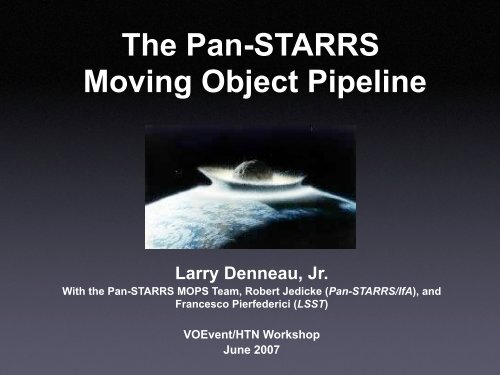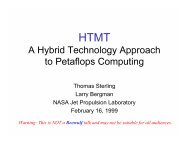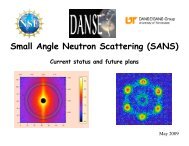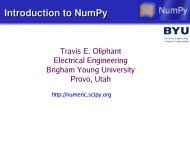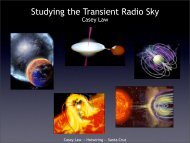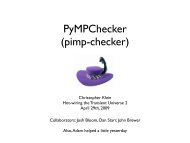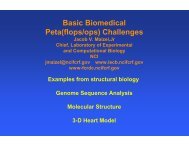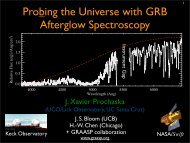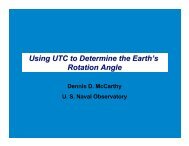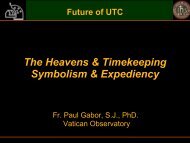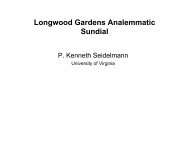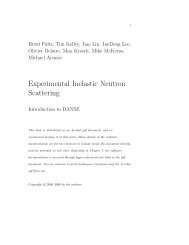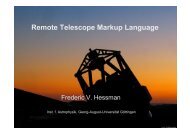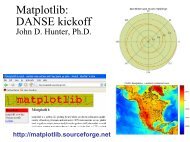The Pan-STARRS Moving Object Pipeline
The Pan-STARRS Moving Object Pipeline
The Pan-STARRS Moving Object Pipeline
You also want an ePaper? Increase the reach of your titles
YUMPU automatically turns print PDFs into web optimized ePapers that Google loves.
<strong>The</strong> <strong>Pan</strong>-<strong>STARRS</strong><br />
<strong>Moving</strong> <strong>Object</strong> <strong>Pipeline</strong><br />
Larry Denneau, Jr.<br />
With the <strong>Pan</strong>-<strong>STARRS</strong> MOPS Team, Robert Jedicke (<strong>Pan</strong>-<strong>STARRS</strong>/IfA), and<br />
Francesco Pierfederici (LSST)<br />
VOEvent/HTN Workshop<br />
June 2007
<strong>Pan</strong>-<strong>STARRS</strong> Overview<br />
• Wide field (7 deg 2 )<br />
• 1.4G pixels/image<br />
• ~0.3 arcsec pixels<br />
• Limiting magnitude R=24.0<br />
• 10-year survey<br />
• Operational 2011 (?)<br />
PS4<br />
telescope rendering (<strong>Pan</strong>-<br />
<strong>STARRS</strong>)
PS1 Overview<br />
• Wide field (7 deg 2 )<br />
• 1.4G pixels/image<br />
• ~0.3 arcsec pixels<br />
• Limiting magnitude R=22.5<br />
• 3-year survey<br />
• Jan 2008 operation<br />
PS1<br />
Enclosure and telescope<br />
with mirror covers closed. (Brett<br />
Simpson, http://ps1sc.org)
What is MOPS?<br />
Transient<br />
Detections<br />
MOPS<br />
Orbits<br />
• 99% PHOs d > 1km<br />
• 90% PHOs d > 300m
What is MOPS?
What is MOPS?<br />
•<br />
Software pipeline for automatic<br />
asteroid discovery<br />
•<br />
•<br />
Prototype developed by <strong>Pan</strong>-<strong>STARRS</strong><br />
Continuing co-development with LSST
What is MOPS?<br />
•<br />
•<br />
•<br />
~200 GFLOPS cluster + 10TB database<br />
Significant contributions from CMU<br />
Auton Lab, JPL, OrbFit Consortium
MOPS Concepts<br />
Tracklets<br />
Single-night associations of<br />
detections separated by TTI that<br />
satisfy v < v max
MOPS Concepts<br />
Tracklets<br />
Neighbors in time and space
MOPS Concepts<br />
Tracklets<br />
X<br />
X<br />
X<br />
Elongated detections help find fast-movers
MOPS Concepts<br />
Tracks<br />
Inter-night associations of tracklets<br />
that satisfy ~quadratic sky-plane<br />
motion<br />
>250X false linkages<br />
for every correct<br />
linkage
Inter-night Linking:<br />
Tracks<br />
Tracklet groups with approximate<br />
asteroidal motion on the sky
Spatial Searching<br />
y<br />
T 1<br />
x<br />
T 2 T 3 T 4<br />
t<br />
Kubica 2006<br />
Efficient proximity searching using KD-trees
Orbit Determination<br />
•<br />
•<br />
•<br />
Cull likely objects from linkages<br />
Tracklets x 3 nights = provisional orbit<br />
OrbFit IOD<br />
• JPL Solar System Dynamics<br />
ephemerides and differential correction
PS1 3π Survey<br />
+90<br />
g<br />
g<br />
z<br />
z<br />
y<br />
y<br />
r<br />
r<br />
y<br />
y<br />
z<br />
z<br />
i<br />
i<br />
30deg<br />
30deg 30deg<br />
30deg 60deg<br />
60deg 30deg<br />
30deg 30deg<br />
30deg<br />
-30
MOPS Synthetic Solar<br />
System<br />
10,842,000<br />
Synthetic <strong>Object</strong>s
Results<br />
Intra-Night<br />
Tracklets<br />
Pct<br />
99.91%<br />
Type<br />
Pct<br />
NEO 97%<br />
Inter-Night<br />
MB >99%<br />
TNO >99%<br />
False ~250X<br />
One-lunation simulation, complete (11M objects) solar<br />
system model
MOPS Transient Events<br />
SYNTHETIC<br />
OBJECTS and<br />
SURVEY<br />
MOPS<br />
IPP TRANSIENT<br />
DETECTIONS<br />
SYNTHETIC<br />
FIELDS<br />
TRACKLETS<br />
(DETECTION PAIRS)<br />
TRACKS<br />
(PROPOSED<br />
LINKAGES)<br />
DATABASE<br />
ORBITS<br />
WORLD
MOPS Transient Events<br />
• “Interesting” high-confidence (~10σ)<br />
tracklet<br />
• Occur at field ingest of TTI pair<br />
• 30-minute latency from IPP<br />
• MOPS tracklet latency < 1 day
MOPS Transient Events<br />
• “Interesting” orbit<br />
• Occur at link-time, usually 3rd night<br />
of observation of an object<br />
• Consideration of survey and/or<br />
visibility constraints
<strong>Pan</strong>-<strong>STARRS</strong> Transient<br />
Events Data Release<br />
• PS1 transient science client under<br />
development<br />
• Mechanism and other details TBD<br />
• PS4 TBD
What Next?<br />
• MOPS: coming soon!<br />
• PS + LSST = good<br />
• Probable support of VOEvents<br />
• Further input from community
Dick Adair, Honolulu Advertiser


